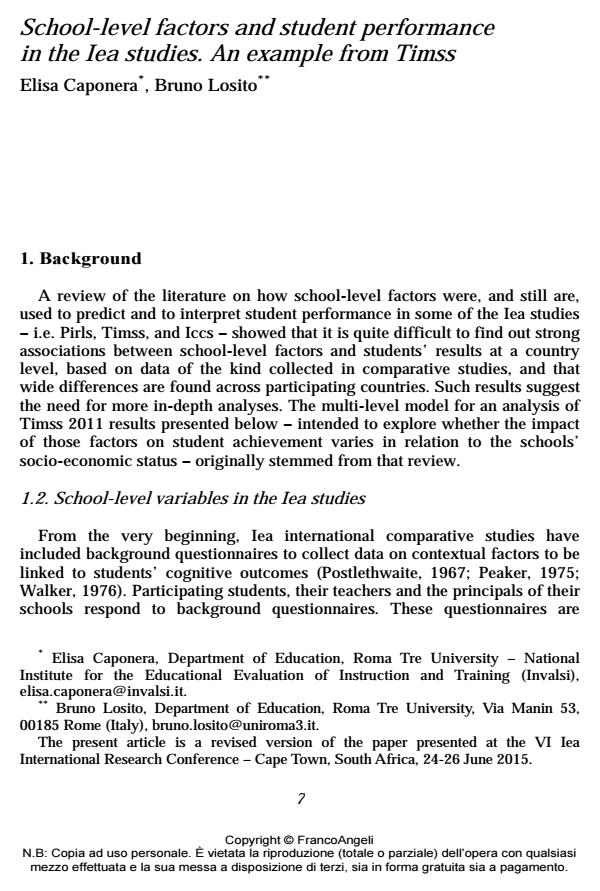School-level factors and student performance in the Iea studies. An example from Timss
Titolo Rivista CADMO
Autori/Curatori Elisa Caponera, Bruno Losito
Anno di pubblicazione 2016 Fascicolo 2015/2
Lingua Inglese Numero pagine 20 P. 7-26 Dimensione file 92 KB
DOI 10.3280/CAD2015-002003
Il DOI è il codice a barre della proprietà intellettuale: per saperne di più
clicca qui
Qui sotto puoi vedere in anteprima la prima pagina di questo articolo.
Se questo articolo ti interessa, lo puoi acquistare (e scaricare in formato pdf) seguendo le facili indicazioni per acquistare il download credit. Acquista Download Credits per scaricare questo Articolo in formato PDF

FrancoAngeli è membro della Publishers International Linking Association, Inc (PILA)associazione indipendente e non profit per facilitare (attraverso i servizi tecnologici implementati da CrossRef.org) l’accesso degli studiosi ai contenuti digitali nelle pubblicazioni professionali e scientifiche
Iea international comparative studies traditionally include the use of background questionnaires. Data collected through those questionnaires are central to both international reports and secondary analyses, as they allow to better contextualize student results in the cognitive tests and help identify the school and classroom factors that have a direct or indirect impact on student performance. A systematic review of the literature on Pirls, Timss, and Iccs was conducted upstream, to identify those school, teacher, and classroom factors which are potentially useful predictors of student performance. Such a review highlighted that it is exceedingly difficult to draw causal inferences, as well as to find strong associations between process-related school variables and student achievement. The type of constructs and variables used in the questionnaire development, the way these constructs and variables are operationally defined, the self-reported nature of the collected data, and the kind of data analyses carried out all contribute to explain that difficulty. In order to verify whether the impact of specific school and teacher characteristics varies as a function of the socioeconomic status of students at the school level, a hierarchical multilevel analysis of Timss 2011 data was conducted. Data from the European countries particvipating in the survey were included in the analyses.The analysis measured what proportion of the variance was actually explained by the factors included in the model and whether the impact of the same factors varies in relation to the school socioeconomic background. A separate analysis was conducted for each considered country and the same multi-level regression model was used first on the schools as a whole, and then treating schools with high and low socioeconomic backgrounds (based on average student Ses at school level) as two distinct groups. In most countries, results showed the influence of socioeconomic status at school level for all three groups of schools - all schools, high Ses schools, and low Ses schools. Furthermore, results showed that school and teacher characteristics have different impacts across countries and in relation to school socioeconomic backgrounds.
Parole chiave:Timss, Pirls, Iccs, school factors, contextual questionnaires
Elisa Caponera, Bruno Losito, School-level factors and student performance in the Iea studies. An example from Timss in "CADMO" 2/2015, pp 7-26, DOI: 10.3280/CAD2015-002003